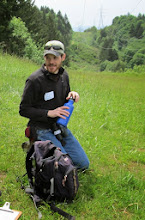
Over the years I have learned that fire kills the above-ground portion of the trees. In some trees, however, the root crowns survive and produce reprouts that can grow to the height of the original tree. After six to ten years of growth, resprouts can produce seeds, but the long-term effects of wildfire on cottonwood populations remain unknown.
Last week in New Mexico, I came across two remarkable cottonwoods in a small wildfire site. Judging from the height of nearby saltcedar resprouts, I would guess that the area had burned in April or May.
One cottonwood was a male, judging from the pollen-producing catkins in its canopy.

He had been scorched at least three quarters of its height, yet he continues to support leaves and reproductive parts. Most cottonwoods burned that much do not produce leaves or soon drop them. A few meters away, a female cottonwood had also been scorched by the fire.

Unlike the male, she had no leaves and likely will never again unless she resprouts. Instead of leaves, her canopy was filled with seed-releasing inflorescences. If I am anthropomorphizing here, but it seems that, being burned and knowing she would not produce seeds for a long time, if ever again, she put all her energy into making one last seed crop, instead of leafing out to make sugar for growth and future reproduction. Unfortunately few if any seeds will go on to becomre trees to replace her. Cottonwoods are notoriously picky about their preffered germination sites, which is why there are no baby cottonwoods in the bosque.
To successfully germinate, a cottonwood seed needs an area cleared of competing vegetation, moist soil, water from below the surface of the soil that is drawn up to where baby roots can reach it, and a decline in the water depth that is not faster than the roots are capable of growing. These conditions usually exist at some point, but rarely at the same time, hence the old cottonwoods that are not being replaced.
A hypothesis I have been working on is that wildfire sites like this one could provide a means for cottonwoods to germinate. The fire has cleared the competing vegetation and high runnoff from the deep winter snowpack has resulted in moist soil in flooded areas.

The female's seeds had settled in the moist soil, so they many germinate!
If the flood waters recede at the right pace, the old cottonwood female may get to reproduce after all. One thing that I am not sure of is whether burned soils allow germination. Since I would be leaving New Mexico soon, I brought some of the study site home with me. Before leaving, I scooped up some soil and bagged a few seeds from the old cottonwood.
Yesterday I began a mini experiement to see if they germinate.

I separated seeds from their pods, then buried them in small planters filled with wildfire and unburned plot soils.
 To replicate a flood, I set the planters in a large plot and filled it with water. I will gradually lower the water level to emulate a receding flood. To recreate New Mexico conditions, I used the covered bed of my truck, which I rarely drive, into a greenhouse. The black lining helped the greenhouse heat up to a New Mexico-like 90 degrees.
To replicate a flood, I set the planters in a large plot and filled it with water. I will gradually lower the water level to emulate a receding flood. To recreate New Mexico conditions, I used the covered bed of my truck, which I rarely drive, into a greenhouse. The black lining helped the greenhouse heat up to a New Mexico-like 90 degrees.I will report results from my experiment as they develop.






No comments:
Post a Comment